Pioneer DEH-P640 User Manual
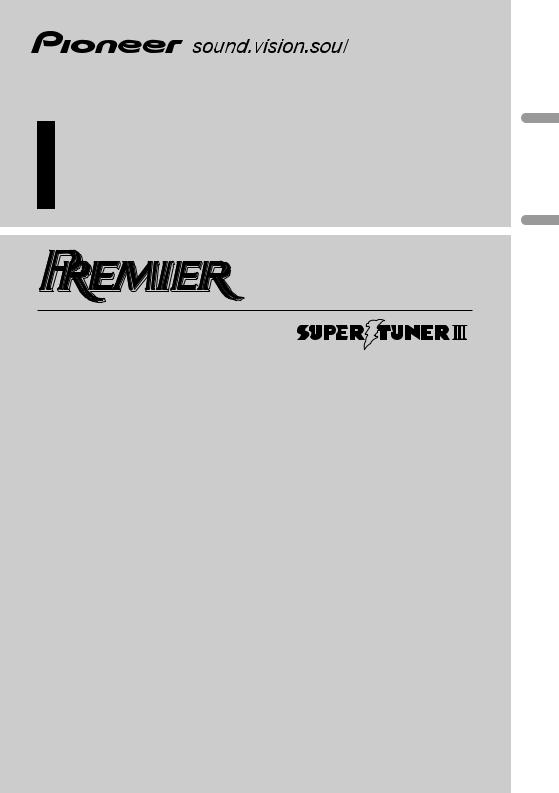
Multi-CD control High power CD player with FM/AM tuner
Syntoniseur FM/AM et lecteur de CD,“Puisance élevée”, avec contrôleur pour lecteur de CD á chargeur
Operation Manual
DEH-P640
Mode d’emploi
English
Français
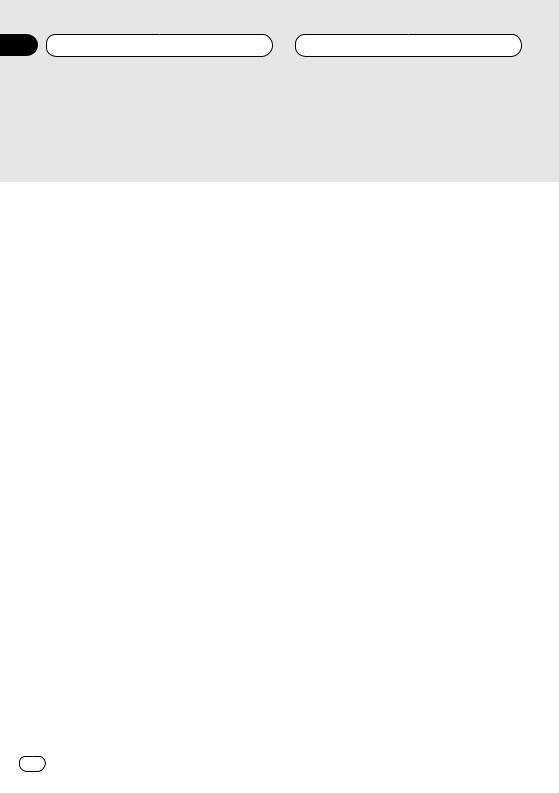
Section
00 Contents
Pioneer product.
instructions so you will know how to oper- finished reading the instructions, put them
 Before You Start
Before You Start
About this unit 6 About this manual 6
After-sales service for Pioneer products 6 Precautions 7
Use and care of the remote control 7
•Installing the battery 7
•Using the remote control 7 About the XM READY mark 8 Protecting your unit from theft 8
•Removing the front panel 8
•Attaching the front panel 9 About the demo mode 9
•Reverse mode 9
•Feature demo 9
What’s what 10
•Head Unit 10
•Remote control 11
 Power ON/OFF
Power ON/OFF
Turning the unit on 12
Selecting a source 12
Turning the unit off 12
 Tuner
Tuner
Listening to the radio 13 Introduction of advanced tuner
operation 14
Storing and recalling broadcast frequencies 14
Tuning in strong signals 15 Storing the strongest broadcast
frequencies 15
 Built-in CD Player
Built-in CD Player
Playing a CD 16
Introduction of advanced built-in CD player operation 17
Repeating play 17
Playing tracks in a random order 17 Scanning tracks of a CD 18 Pausing CD playback 18
Using disc title functions 18
•Entering disc titles 18
•Displaying disc titles 19 Using CD TEXT functions 19
•Displaying titles on CD TEXT discs 19
•Scrolling titles in the display 19
2 En

Section
Contents 00
00
 Audio Adjustments
Audio Adjustments
Introduction of audio adjustments 27 Setting the sound focus equalizer 27 Using balance adjustment 28
Using the equalizer 28
•Recalling equalizer curves 28
•Adjusting equalizer curves 29
•Fine adjusting equalizer curve 29 Adjusting bass 30
Adjusting treble 30 Adjusting loudness 30 Using subwoofer output 30
•Adjusting subwoofer settings 31 Using non fading output 31
•Adjusting non fading output level 31 Using the high pass filter 32
Adjusting source levels 32
 Initial Settings
Initial Settings
Adjusting initial settings 33 Setting the time 33
Switching the warning tone 33 Switching the auxiliary setting 34 Switching the dimmer setting 34 Selecting the brightness 34 Setting the rear output and
subwoofer controller 34 Switching the Telephone
Muting/Attenuation 35
English
Español
Italiano Français Deutsch
Nederlands
En 3
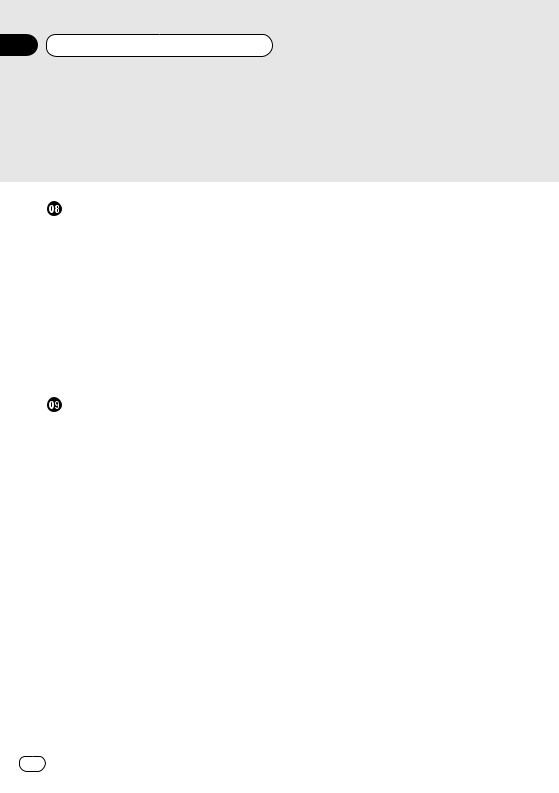
Section
00 Contents
4 En
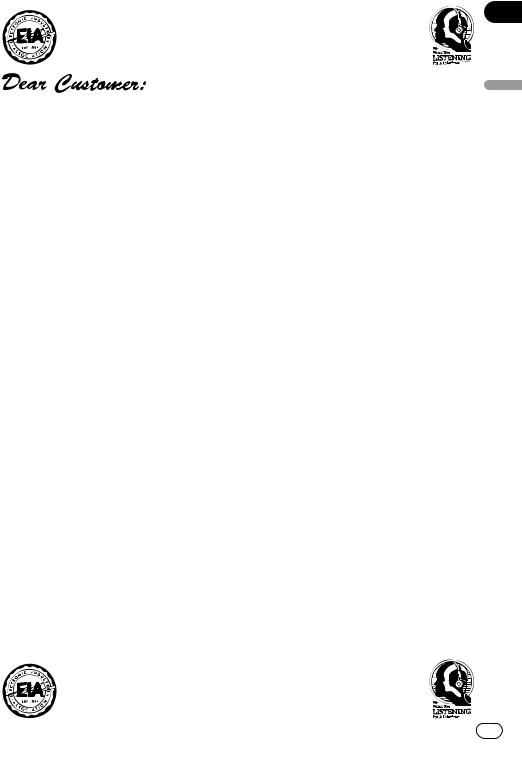
Section
00
Selecting fine audio equipment such as the unit you’ve just purchased is only the start of your musical enjoyment. Now it’s time to consider how you can maximize the fun and excitement your equipment offers. This manufacturer and the Electronic Industries Association’s Consumer Electronics Group want you to get the most out of your equipment by playing it at a safe level. One that lets the sound come through loud and clear without annoying blaring or distortion—and, most importantly, without affecting your sensitive hearing.
Sound can be deceiving. Over time your hearing “comfort level” adapts to higher volumes of sound. So what sounds “normal” can actually be loud and harmful to your hearing. Guard against this by setting your equipment at a safe level BEFORE your hearing adapts.
To establish a safe level:
•Start your volume control at a low setting.
•Slowly increase the sound until you can hear it comfortably and clearly, and without distortion.
Once you have established a comfortable sound level:
• Set the dial and leave it there.
Taking a minute to do this now will help to prevent hearing damage or loss in the future. After all, we want you listening for a lifetime.
We Want You Listening For A Lifetime
Used wisely, your new sound equipment will provide a lifetime of fun and enjoyment. Since hearing damage from loud noise is often undetectable until it is too late, this manufacturer and the Electronic Industries Association’s Consumer Electronics Group recommend you avoid prolonged exposure to excessive noise. This list of sound levels is included for your protection.
Decibel
Level Example
30 Quiet library, soft whispers
40 Living room, refrigerator, bedroom away from traffic
50 Light traffic, normal conversation, quiet office
60 Air conditioner at 20 feet, sewing machine
70 Vacuum cleaner, hair dryer, noisy restaurant
80 Average city traffic, garbage disposals, alarm clock at two feet.
THE FOLLOWING NOISES CAN BE DANGEROUS UNDER CONSTANT EXPOSURE
90 Subway, motorcycle, truck traffic, lawn mower
100 Garbage truck, chain saw, pneumatic drill
120 Rock band concert in front of speakers, thunderclap
140 Gunshot blast, jet plane
180 Rocket launching pad
Information courtesy of the Deafness Research Foundation.
English
Español
Italiano Français Deutsch
Nederlands
En 5

Section
01 Before You Start
About this unit
The tuner frequencies on this unit are allocated for use in North America. Use in other areas may result in improper receiption.
 Important
Important
The serial number is located on the bottom of this unit. For your own security and convenience, be sure to record this number on the enclosed warranty card. 
About this manual
This unit features a number of sophisticated functions ensuring superior reception and operation. All the functions have been designed for the easiest possible use, but many are not selfexplanatory. This operation manual will help you benefit fully from this product’s potential and to maximize your listening enjoyment.
We recommend that you familiarize yourself with the functions and their operation by reading through the manual before you begin using this unit. It is especially important that you read and observe precautions on this page and in other sections.
This manual explains head unit operation. You can perform the same operations with the remote control. 
After-sales service for Pioneer products
Please contact the dealer or distributor from where you purchased this unit for after-sales service (including warranty condtions) or any other information. In case the necessary information is not available, please contact the companies listed below:
Please do not ship your unit to the companies at the addresses listed below for repair without advance contact.
U.S.A.
Pioneer Electronics (USA), Inc. CUSTOMER SUPPORT DIVISION P.O. Box 1760
Long Beach, CA 90801-1760 800-421-1404
CANADA
Pioneer Electronics of Canada, Inc. CUSTOMER SATISFACTION DEPARTMENT 300 Allstate Parkway
Markham, Ontario L3R OP2 (905) 479-4411 1-877-283-5901
For warranty information please see the Limited Warranty sheet included with this unit. 
6 En
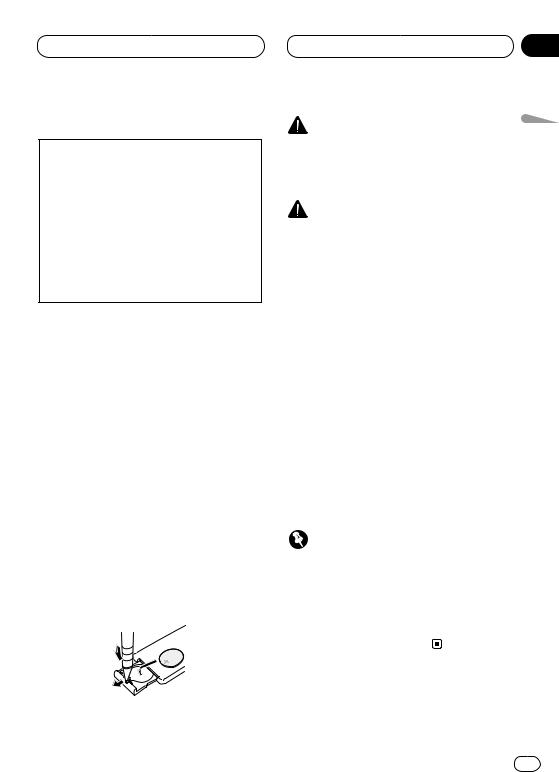
Before You Start
Precautions
CAUTION: USE OF CONTROL OR ADJUSTMENT OR PERFORMANCE OF PROCEDURES OTHER THAN THOSE SPECIFIED HEREIN MAY RESULT IN HAZARDOUS RADIATION EXPOSURE.
CAUTION: THE USE OF OPTICAL INSTRUMENTS WITH THIS PRODUCT WILL INCREASE EYE HAZARD.
•Keep this manual handy as a reference for operating procedures and precautions.
•Always keep the volume low enough so you can hear sounds outside of the car.
•Protect this product from moisture.
•If the battery is disconnected or discharged, the preset memory will be erased and must be reprogrammed. 
Use and care of the remote control
Installing the battery
Slide the tray out on the back of the remote control and insert the battery with the plus (+) and minus (–) poles pointing in the proper direction.
Section
01
WARNING |
English |
|
Keep the battery out of the reach of children. |
||
|
||
Should the battery be swallowed, immediately |
|
|
consult a doctor. |
|
|
CAUTION |
|
|
• Use only one CR2025 (3V) lithium battery. |
Español |
|
• Remove the battery if the remote control is not |
||
|
||
to be used for a month or longer. |
|
|
• Do not recharge, disassemble, heat or dis- |
|
|
pose of battery in fire. |
|
|
• Do not handle the battery with metallic tools. |
|
|
• Do not store the battery with metallic materi- |
|
|
als. |
Deutsch |
|
• In the event of battery leakage, wipe the |
||
|
||
remote control completely clean and install a |
|
|
new battery. |
|
|
• When disposing of used batteries, please |
|
|
comply with governmental regulations or |
|
|
environmental public institution’s rules that |
|
|
apply in your country/area. |
Français |
|
Using the remote control |
||
|
||
Point the remote control in the direction of the |
|
|
front panel to operate. |
|
|
Important |
Italiano |
|
• Do not store the remote control in high tem- |
||
|
||
peratures or direct sunlight. |
|
|
• The remote control may not function properly |
|
|
in direct sunlight. |
|
|
• Do not let the remote control fall onto the |
|
|
floor, where it may become jammed under the |
|
|
brake or accelerator pedals. |
Nederlands |
|
|
En 7
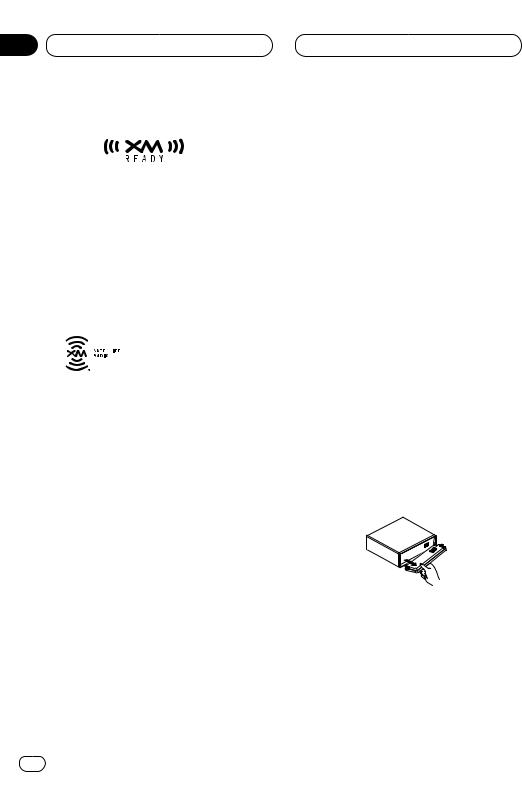
Section
01 Before You Start
About the XM READY mark
The XM READY mark printed on the front panel indicates that the Pioneer XM tuner (sold separately) can be controlled by this unit. Please inquire to your dealer or nearest authorized Pioneer service station regarding the XM tuner that can be connected to this unit. For XM tuner operation, please refer to the XM tuner owner’s manual.
 Notes
Notes
•XM Satellite Radio is developing a new band of radio in the U.S.A.
The system will use direct satellite-to-receiver broadcasting technology to provide listeners in their cars and at home with crystal-clear sound seamlessly from coast to coast. XM will create and package up to 100 channels of digital-quality music, news, sports, talk and children’s programming. 
Protecting your unit from theft
The front panel can be detached from the head unit and stored in the protective case provided to discourage theft.
•If the front panel is not detached from the head unit within five seconds of turning off the ignition, a warning tone will sound.
•You can turn off the warning tone. See
Switching the warning tone on page 33.
 Important
Important
•Never use force or grip the display and the buttons tightly when removing or attaching.
•Avoid subjecting the front panel to excessive shocks.
•Keep the front panel out of direct sunlight and high temperatures.
Removing the front panel
1Press OPEN to open the front panel.
2Grip the left side of the front panel and pull it gently outward.
Take care not to grip it tightly or drop it.
3 Put the front panel into the protective case provided for safe keeping.
8 En
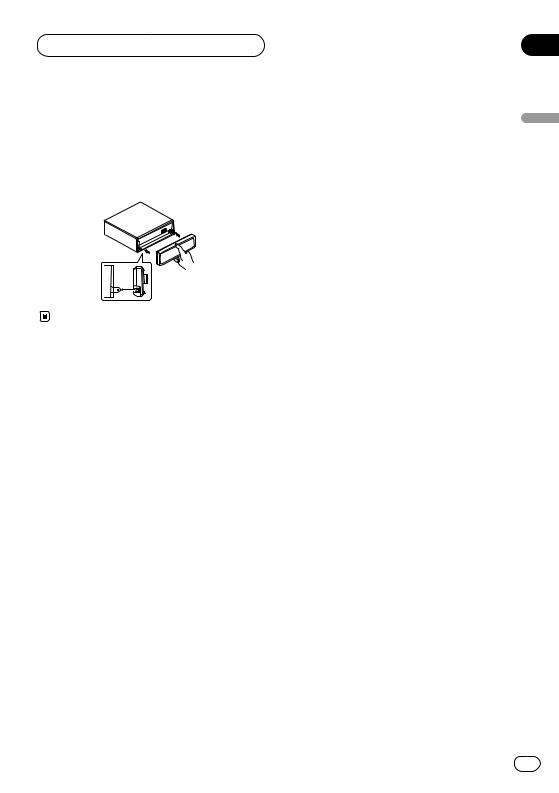
Section
Before You Start 01
01
Attaching the front panel
Replace the front panel by holding it upright to this unit and clipping it securely into the mounting hooks.
About the demo mode
This product features two demonstration modes. one is the reverse mode, the other is the feature demo mode.
Reverse mode
If you do not perform an operation within about 30 seconds, screen indications start to reverse, and then continue reversing every 10 seconds.
Pressing 5 numbered button when power to this product is switched off while the ignition switch is set to ACC or ON cancels the reverse mode.
Pressing 5 numbered button again to start the reverse mode.
Feature demo
The feature demo automatically starts when power to this product is switched off while the ignition switch is set to ACC or ON. Pressing 6 numbered button during feature demo operation cancels the feature demo mode. Pressing 6 numbered button again to start the feature mode. remember that if the feature demo continues operating when the car engine is switched off, it may drain battery power.
 Notes
Notes
•You cannot cancel a demo mode when the front panel is open.
•The red lead (ACC) of this product should be connected to a terminal coupled with ignition switch on/off operations. If this is not done, the vehicle battery may be drained. 
English
Español
Italiano Français Deutsch
Nederlands
En 9
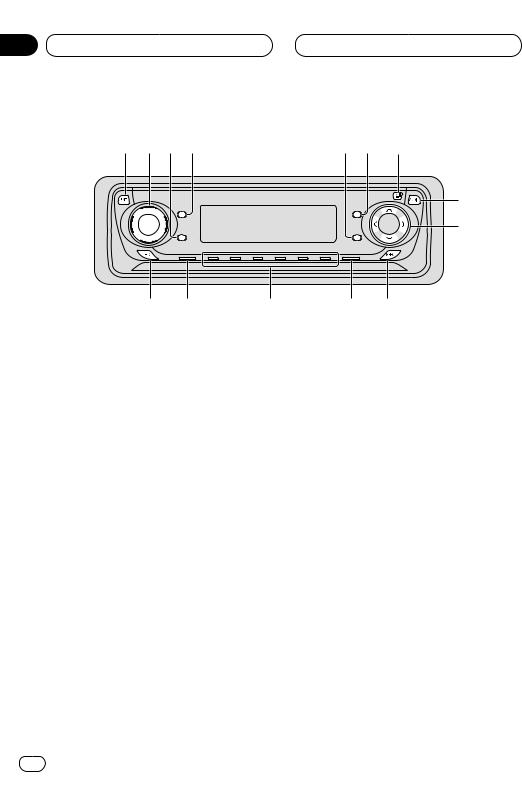
Section
01 Before You Start
1 2 3 4
! ~ |
= |
What’s what
Head Unit
1ENTERTAINMENT button
Press to change to the entertainment display.
2VOLUME
When you press the VOLUME, it extends outward so that it becomes easier to turn. To retract the VOLUME, press it again. Rotate to increase or decrease the volume.
3CLOCK button
Press to change to the clock display.
4DISPLAY button
Press to select different displays.
5PAUSE button
Press to pause play.
6FUNCTION button
Press to select functions.
10 En
5 6 7
8
SELECT |
9 |
-0
7OPEN button
Press to open the front panel.
8AUDIO button
Press to select various sound quality controls.
95/∞/2/3 buttons
Press to do manual seek tuning, fast forward, reverse and track search controls. Also used for controlling functions.
0SFEQ button
Press to select a natural sound with presence.
-BAND/ESC button
Press to select among three FM and one AM bands and cancel the control mode of functions.
=1–6 (PRESET TUNING) buttons
Press for preset tuning and disc number search when using a multi-CD player.
~SOURCE button
This unit is switched on by selecting a source. Press to cycle through all of the available sources.
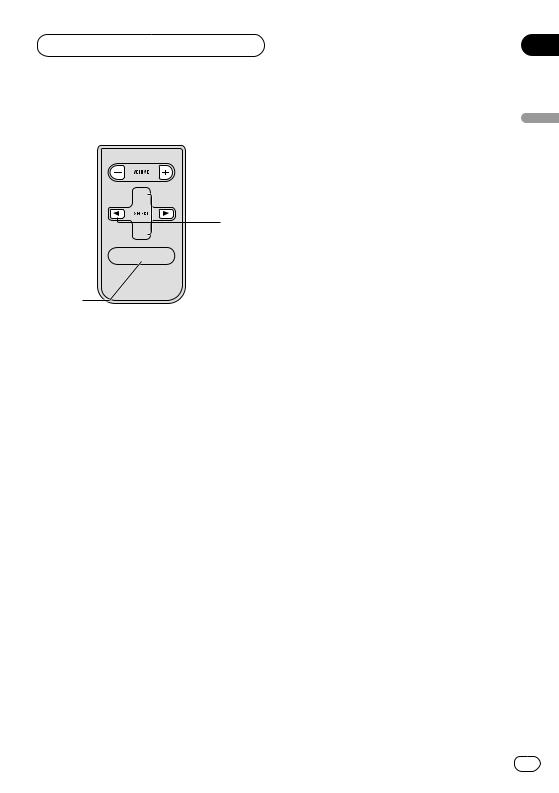
Section
Before You Start 01
01
 @
@
-


 %
%
 9 6
9 6


 8
8
#

 $
$
5
!EQ button
Press to select various equalizer curves. 
Remote control
English
Español
Deutsch
The supplied remote control enables convenient remote operation of the head unit. Operation is the same as when using button on the head unit.
@VOLUME button
Press to increase or decrease the volume.
Français
#CD button
Press to select the built-in or multi-CD player as source.
$TUNER button
Press to select the tuner as source.
Italiano
%ATT button
Press to quickly lower the volume level, by about 90%. Press once more to return to the original volume level. 
Nederlands
En 11

Section
02 Power ON/OFF
Turning the unit on
Press SOURCE to turn the unit on.
When you select a source the unit is turned on.
Selecting a source
You can select a source you want to listen to. To switch to the built-in CD player, load a disc in this unit (refer to page 16).
• When using the head unit, press SOURCE to select a source.
Press SOURCE repeatedly to switch between the following sources:
Built-in CD player—TV—Tuner—XM tuner— Multi-CD player—External unit 1—External unit 2
—AUX
• When using the remote control, press TUNER, or CD to select a source.
Press each button repeatedly to switch between the following sources:
TUNER: TV—Tuner—XM tuner—Sources off CD: Built-in CD player—Multi-CD player—
Sources off
 Notes
Notes
•In the following cases, the sound source will not change:
—When a product corresponding to each source is not connected to this unit.
—When no disc is set in this unit.
—When no magazine is set in the multi-CD player.
—When the AUX (auxiliary input) is set to off (refer to page 34).
•External unit refers to a Pioneer product (such as one available in the future) that, although incompatible as a source, enables control of basic functions by this unit. Two external units can be controlled by this unit. When two external units are connected, the allocation of them to external unit 1 or external unit 2 is automatically set by this unit.
•When this unit’s blue/white lead is connected to the car’s auto-antenna relay control terminal, the car’s antenna extends when this unit’s source is switched on. To retract the antenna, switch the source off. 
Turning the unit off
Press SOURCE and hold for at least one second to turn the unit off. 
12 En
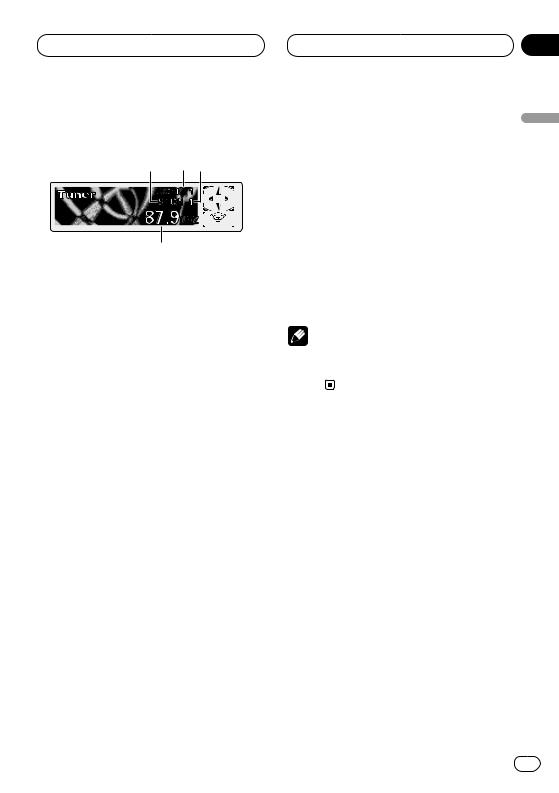
Tuner
Listening to the radio
1 2 3
4
These are the basic steps necessary to operate the radio. More advanced tuner operation is explained starting on page 14.
1STEREO (ST) indicator
Shows that the frequency selected is being broadcast in stereo.
2BAND indicator
Shows which band the radio is tuned to, AM or FM.
3PRESET NUMBER indicator
Shows what preset has been selected.
4FREQUENCY indicator
Shows to which frequency the tuner is tuned.
1 Press SOURCE to select the tuner.
Press SOURCE until you see Tuner displayed.
2Use VOLUME to adjust the sound level.
Rotate to increase or decrease the volume.
3Press BAND/ESC to select a band.
Press BAND/ESC until the desired band is displayed, FM1, FM2, FM3 for FM or AM.
Section
03
4 To perform manual tuning, press 2 or 3 |
|
|
with quick presses. |
English |
|
The frequencies move up or down step by step. |
||
|
||
5 To perform seek tuning, press and hold 2 |
|
|
or 3 for about one second and release. |
|
|
The tuner will scan the frequencies until a |
|
|
broadcast strong enough for good reception is |
|
|
found. |
Español |
|
• You can cancel seek tuning by pressing either |
||
|
||
2 or 3 with a quick press. |
|
|
• If you press and hold 2 or 3 you can skip |
|
|
broadcasting stations. Seek tuning starts as |
|
|
soon as you release the buttons. |
|
|
Note |
Deutsch |
|
• When the frequency selected is being broad- |
||
|
||
cast in stereo the STEREO (ST ) indicator will |
|
|
light. |
|
|
|
Français |
|
|
Italiano |
|
|
Nederlands |
En 13
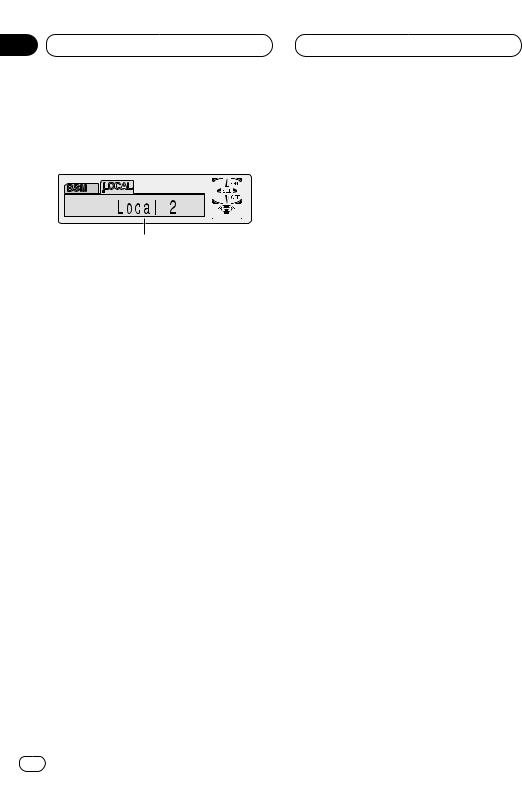
Section
03 Tuner
Introduction of advanced tuner |
Storing and recalling broadcast |
operation |
frequencies |
1
1FUNCTION display
Shows the function status.
Press FUNCTION to display the function names.
Press FUNCTION repeatedly to switch between the following functions:
BSM (best stations memory)—LOCAL (local seek tuning)
• To return to the frequency display, press
BAND/ESC.
 Note
Note
•If you do not operate the function within about 30 seconds, the display is automatically returned to the frequency display. 
If you press any of the PRESET TUNING buttons you can easily store up to six broadcast frequencies for later recall with the touch of a button.
When you find a frequency that you want to store in memory press a PRESET TUNING button and hold until the preset number stops flashing.
The number you have pressed will flash in the PRESET NUMBER indicator and then remain lit. The selected radio station frequency has been stored in memory.
The next time you press the same PRESET TUNING button the radio station frequency is recalled from memory.
 Notes
Notes
•Up to 18 FM stations, 6 for each of the three FM bands, and 6 AM stations can be stored in memory.
•You can also use 5 and ∞ to recall radio station frequencies assigned to PRESET TUNING buttons. 
14 En

Tuner
Tuning in strong signals
Local seek tuning lets you tune in only those radio stations with sufficiently strong signals for good reception.
1Press FUNCTION to select LOCAL.
Press FUNCTION until Local appears in the display.
2Press 5 to turn local seek tuning on.
Local seek sensitivity (e.g., Local 2) appears in the display.
3Press 2 or 3 to set the sensitivity.
There are four levels of sensitivity for FM and two levels for AM:
FM: Local 1—Local 2—Local 3—Local 4 AM: Local 1—Local 2
The Local 4 setting allows reception of only the strongest stations, while lower settings let you receive progressively weaker stations.
4 When you want to return to normal seek tuning, press ∞ to turn local seek tuning off.
Local :OFF appears in the display. 
Section
03
Storing the strongest broadcast |
|
|
frequencies |
English |
|
BSM (best stations memory) lets you automati- |
||
|
||
cally store the six strongest broadcast frequen- |
|
|
cies under PRESET TUNING buttons 1–6 and |
|
|
once stored there you can tune in to those fre- |
|
|
quencies with the touch of a button. |
Español |
|
play. |
||
1 Press FUNCTION to select BSM. |
|
|
Press FUNCTION until BSM appears in the dis- |
|
2 Press 5 to turn BSM on.
BSM begins to flash. While BSM is flashing the |
|
|||
six strongest broadcast frequencies will be |
Deutsch |
|||
stored under PRESET TUNING buttons in order |
||||
|
||||
of their signal strength. When finished, BSM |
|
|||
stops flashing. |
|
|||
• To cancel the storage process, press ∞. |
|
|||
|
|
Note |
|
|
|
|
|
||
|
|
|
Français |
|
• Storing broadcast frequencies with BSM may |
||||
|
replace broadcast frequencies you have saved |
|||
|
|
|||
|
using PRESET TUNING. |
|
||
|
|
|
Italiano |
|
Nederlands
En 15
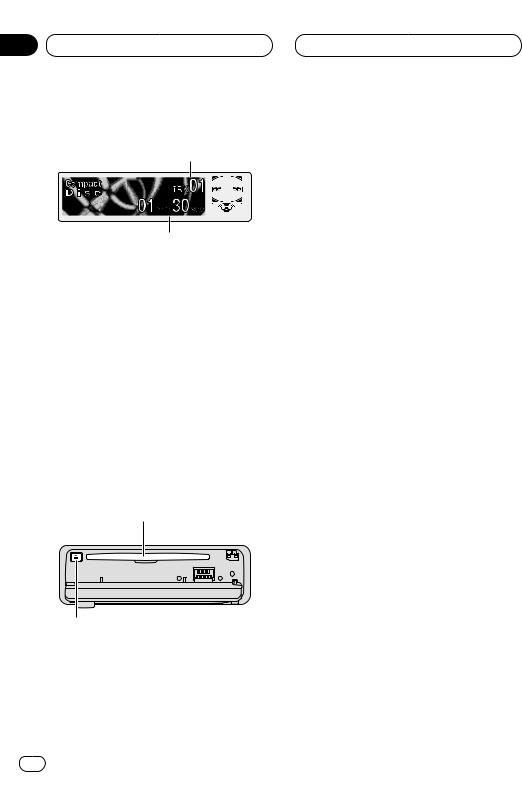
Section
04 Built-in CD Player
Playing a CD
1
2
These are the basic steps necessary to play a CD with your built-in CD player. More advanced CD operation is explained starting on page 17.
1TRACK NUMBER indicator
Shows the track currently playing.
2PLAY TIME indicator
Shows the elapsed playing time of the current track.
1Press OPEN to open the front panel.
CD loading slot appears.
• After inserting a CD, press SOURCE to select the built-in CD player.
2Insert a CD into the CD loading slot.
Playback will automatically start.
CD loading slot
EJECT button
•You can eject a CD by pressing EJECT.
•To avoid a malfunction, make sure that no metal object comes into contact with the front panel is open.
3 After a CD has been inserted, close the front panel.
4Use VOLUME to adjust the sound level.
Rotate to increase or decrease the volume.
5To perform fast forward or reverse, press and hold 2 or 3.
6To skip back or forward to another track, press 2 or 3.
Pressing 3 skips to the start of the next track. Pressing 2 once skips to the start of the current track. Pressing again will skip to the previous track.
 Notes
Notes
•The built-in CD player plays one, standard, 12-cm or 8-cm (single) CD at a time. Do not use an adapter when playing 8-cm CDs.
•Do not insert anything other than a CD into the CD loading slot.
•When CD TEXT disc is inserted,  lights.
lights.
•If you cannot insert a disc completely or if after you insert a disc the disc does not play, check that the label side of the disc is up. Press EJECT to eject the disc, and check the disc for damage before inserting the disc again.
•If the built-in CD player does not operate properly, an error message such as ERROR-11 may be displayed. Refer to Understanding built-in CD player error messages on page 40. 
16 En
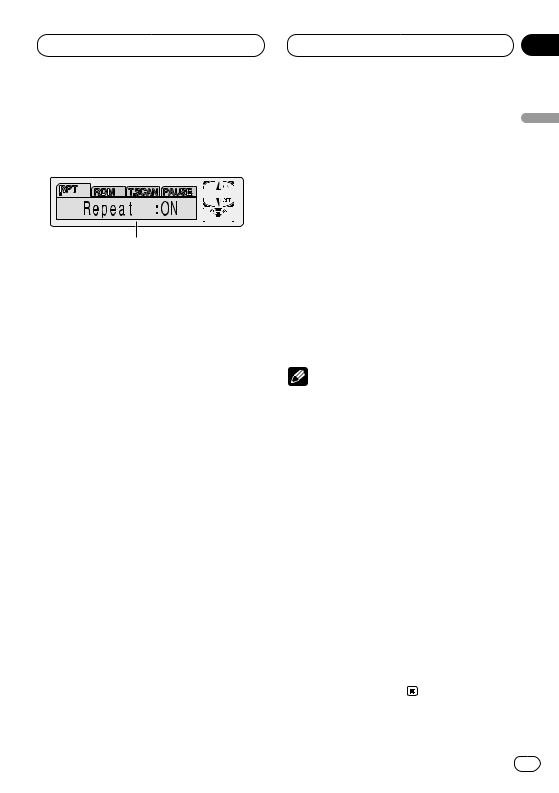
Built-in CD Player
Introduction of advanced built-in CD player operation
1
1FUNCTION display
Shows the function status.
Press FUNCTION to display the function names.
Press FUNCTION repeatedly to switch between the following functions:
RPT (repeat play)—RDM (random play)— T.SCAN (scan play)—PAUSE (pause)
• To return to the playback display, press
BAND/ESC.
 Note
Note
•If you do not operate the function within about 30 seconds, the display is automatically returned to the playback display. 
Section
04
Repeating play
Repeat play lets you hear the same track over |
English |
|||
again. |
||||
|
|
|
||
1 Press FUNCTION to select RPT. |
|
|||
Press FUNCTION until Repeat appears in the |
|
|||
display. |
Español |
|||
2 Press 5 to turn repeat play on. |
||||
|
||||
Repeat :ON appears in the display. The track |
|
|||
presently playing will play and then repeat. |
|
|||
3 Press ∞ to turn repeat play off. |
|
|||
Repeat :OFF appears in the display. The track |
|
|||
presently playing will continue to play and then |
Deutsch |
|||
play the next track. |
||||
|
||||
|
|
Note |
|
|
|
|
|
||
|
|
|
|
|
•If you perform track search or fast forward/reverse, repeat play is automatically cancelled. 
Playing tracks in a random order |
Français |
Random play lets you play back tracks on the |
|
CD in a random order. |
Italiano |
display. |
|
1 Press FUNCTION to select RDM. |
|
Press FUNCTION until Random appears in the |
|
2 Press 5 to turn random play on. |
|
Random :ON appears in the display. Tracks will |
|
play in a random order. |
Nederlands |
3 Press ∞ to turn random play off. |
|
Random :OFF appears in the display. Tracks will |
|
continue to play in order. |
|
|
En 17
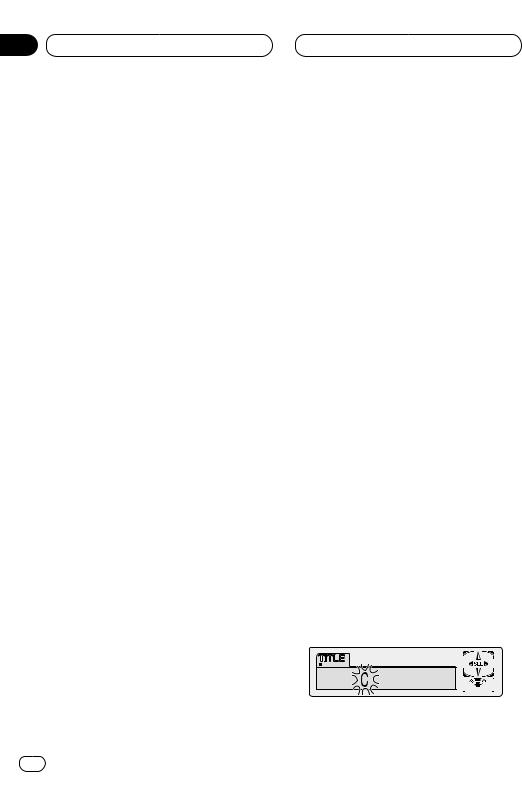
Section
04 Built-in CD Player
Scanning tracks of a CD
Scan play lets you hear the first 10 seconds of each track on the CD.
1Press FUNCTION to select T.SCAN.
Press FUNCTION until Track Scan appears in the display.
2Press 5 to turn scan play on.
Track Scan :ON appears in the display. The first 10 seconds of each track is played.
3 When you find the desired track press ∞ to turn scan play off.
Track Scan :OFF appears in the display. The track will continue to play.
• If the display has automatically returned to the playback display, select T.SCAN again by pressing FUNCTION.
 Note
Note
•After scanning of a CD is finished, normal playback of the tracks will begin again. 
Pausing CD playback
Pause lets you temporarily stop playback of the CD.
1Press FUNCTION to select PAUSE.
Press FUNCTION until Pause appears in the display.
2Press 5 to turn pause on.
Pause :ON appears in the display. Play of the current track pauses.
3 Press ∞ to turn pause off.
Pause :OFF appears in the display. Play will resume at the same point that you turned pause on. 
18 En
Using disc title functions
You can input CD titles and display the title. The next time you insert a CD for which you have entered a title, the title of that CD will be displayed.
Entering disc titles
Disc title input lets you input CD titles up to 10 letters long and up to 48 disc titles into the builtin CD player.
1Play a CD that you want to enter the title.
2Press FUNCTION and hold until TITLE appears in the display.
• When playing a CD TEXT disc, you cannot switch to TITLE. The disc title will have already been recorded on a CD TEXT disc.
3Press 1 numbered button to select the desired character type.
Press 1 numbered button repeatedly to switch between the following character type:
Alphabet (upper case), Numbers and Symbols— Alphabet (lower case)
• You can select to input Numbers and Symbols by pressing 2 numbered button.
4Press 5 or ∞ to select a letter of the alphabet.
Each press of 5 will display a letter of the alphabet in A B C ... X Y Z, numbers and symbols in 1 2
3... @ # < order. Each press of ∞ will display a letter in the reverse order, such as Z Y X ... C B A order.
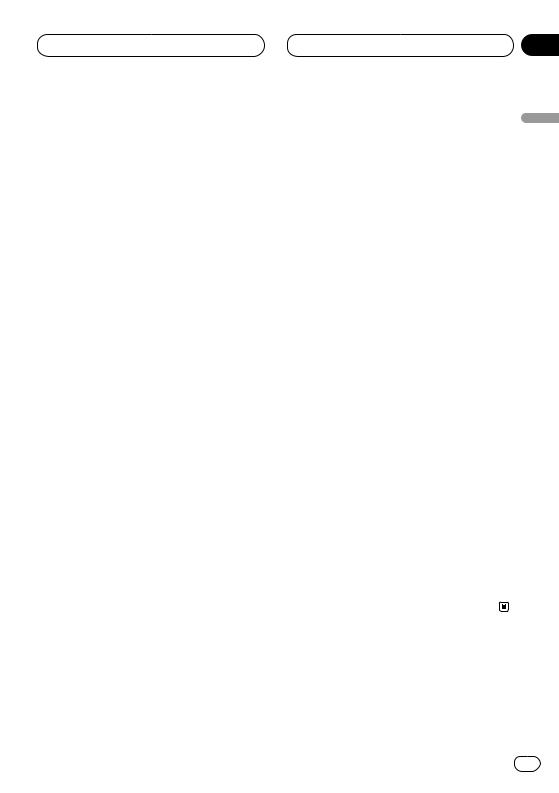
Built-in CD Player
5Press 3 to move the cursor to the next character position.
When the letter you want is displayed, press 3 to move the cursor to the next position and then select the next letter. Press 2 to move backwards in the display.
6Move the cursor to the last position by pressing 3 after entering the title.
When you press 3 one more time, the entered title is stored in memory.
7Press BAND/ESC to return to the playback display.
 Notes
Notes
•Titles remain in memory, even after the disc has been removed from built-in CD player, and are recalled when the disc is reinserted.
•After data for 48 discs has been stored in memory, data for a new disc will overwrite the oldest one.
•If you connect a multi-CD player, you can input disc titles for up to 100 discs.
•When a multi-CD player that does not support disc title function is connected, you cannot enter disc titles in this unit.
Displaying disc titles
You can display the title of any disc that has had a disc title entered.
Press DISPLAY.
Press DISPLAY repeatedly to switch between the following settings:
PLAYBACK MODE (play time)—Disc Title (disc title)
When you select Disc Title, the title of the currently playing disc is shown in the display.
• If no title has been entered for the currently playing disc, NO TITLE is displayed. 
Section
04
Using CD TEXT functions
Some discs have certain information encoded |
English |
|
on the disc during manufacture. These discs |
||
may contain such information as the CD title, |
||
|
||
track title, artist’s name and playback time and |
|
|
are called CD TEXT discs. Only these specially |
|
|
encoded CD TEXT discs support the functions |
|
|
listed below. |
Español |
|
Displaying titles on CD TEXT discs |
||
|
||
Press DISPLAY when playing a CD TEXT disc. |
|
|
Press DISPLAY repeatedly to switch between |
|
|
the following settings: |
Deutsch |
|
PLAYBACK MODE (play time)—Disc Title (disc |
||
|
||
title)—Disc Artist Name (disc artist name)— |
|
|
Track Title (track title)—T-Artist Name (track |
|
|
artist name) |
|
|
• If specific information has not been recorded |
|
|
on a CD TEXT disc, NO XXXX will be displayed |
|
|
(e.g., NO Track Title). |
Français |
|
Scrolling titles in the display |
||
|
||
This unit can display the first 16 letters only of |
|
|
Disc Title, Disc Artist Name, Track Title and T- |
|
|
Artist Name. When the recorded information is |
|
|
longer than 16 letters, you can scroll the text to |
Italiano |
|
Press DISPLAY and hold until the title begins |
||
the left so that the rest of the title can be seen. |
|
|
to scroll to the left. |
|
|
The rest of the title will appear in the display. |
|
|
|
Nederlands |
En 19
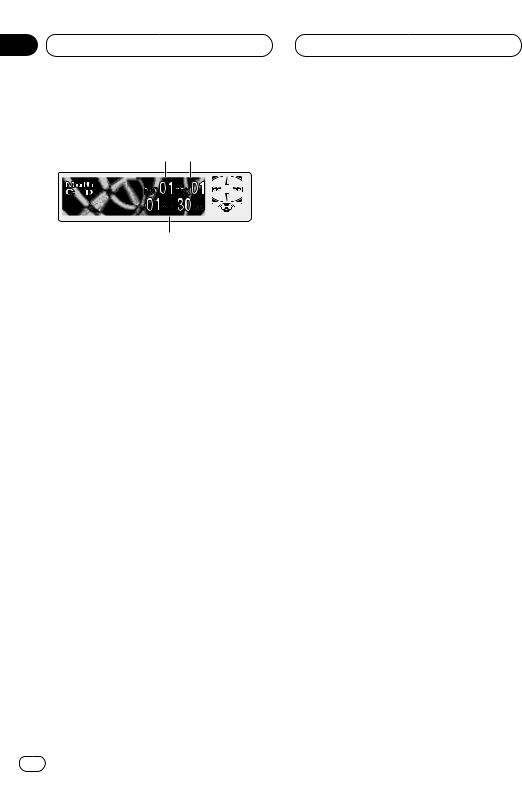
Section
05 Multi-CD Player
Playing a CD
1 2
3
You can use this unit to control a multi-CD player, which is sold separately.
These are the basic steps necessary to play a CD with your multi-CD player. More advanced CD operation is explained starting on page 21.
1DISC NUMBER indicator
Shows the disc currently playing.
2TRACK NUMBER indicator
Shows the track currently playing.
3PLAY TIME indicator
Shows the elapsed playing time of the current track.
1Press SOURCE to select the multi-CD player.
Press SOURCE until you see Multi-CD displayed.
2Use VOLUME to adjust the sound level.
Rotate to increase or decrease the volume.
3Select a disc you want to listen to with the
1to 6 buttons.
For discs located at 1 to 6, press the corresponding number button.
If you want to select a disc located at 7 to 12, press and hold the corresponding numbers such as 1 for disc 7, until the disc number appears in the display.
• You can also sequentially select a disc by pressing 5/∞.
4To perform fast forward or reverse, press and hold 2 or 3.
5To skip back or forward to another track, press 2 or 3.
Pressing 3 skips to the start of the next track. Pressing 2 once skips to the start of the current track. Pressing again will skip to the previous track.
 Notes
Notes
•When the multi-CD player performs the preparatory operations, Ready is displayed.
•If the multi-CD player does not operate properly, an error message such as ERROR-11 may be displayed. Refer to the multi-CD player owner’s manual.
•If there are no discs in the multi-CD player magazine, NO DISC is displayed. 
50-disc multi-CD player
Only those functions described in this manual are supported for 50-disc multi-CD players. 
20 En

Multi-CD Player
Introduction of advanced multiCD player operation
1
1FUNCTION display
Shows the function status.
Press FUNCTION to display the function names.
Press FUNCTION repeatedly to switch between the following functions:
PMODE (repeat play)—T.LIST (disc title list)— RDM (random play)—SCAN (scan play)—ITS-P (ITS play)—PAUSE (pause)—COMP (compression and DBE)
• To return to the playback display, press
BAND/ESC.
 Note
Note
•If you do not operate the function within about 30 seconds, the display is automatically returned to the playback display. 
Section
05
Repeating play
There are three repeat play ranges for the multi- |
English |
|
|
||
CD player: MCD (multi-CD player repeat), TRK |
|
|
(one-track repeat), and DISC (disc repeat). |
|
|
1 Press FUNCTION to select PMODE. |
|
|
Press FUNCTION until Repeat appears in the |
|
|
display. |
Español |
|
2 Press 2 or 3 to select the repeat range. |
||
|
||
Press 2 or 3 until the desired repeat range |
|
|
appears in the display. |
|
|
• MCD — Repeat all discs in the multi-CD |
|
|
player |
|
|
• TRK — Repeat just the current track |
Deutsch |
|
• DISC — Repeat the current disc |
||
|
||
Notes |
|
|
• If you select other discs during repeat play, |
|
|
the repeat play range changes to MCD (multi- |
|
|
CD player repeat). |
|
|
• If you perform track search or fast |
Français |
|
DISC (disc repeat). |
||
forward/reverse during TRK (one-track |
|
|
repeat), the repeat play range changes to |
|
|
|
Italiano |
|
|
Nederlands |
En 21
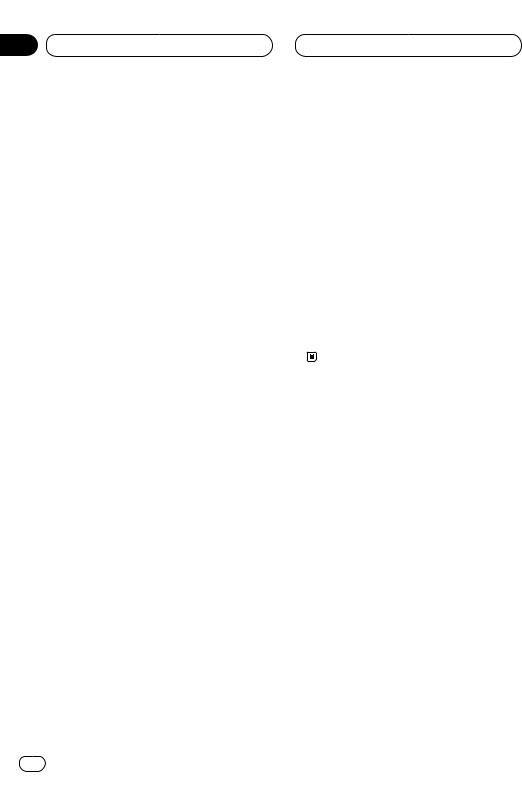
Section
05 Multi-CD Player
Playing tracks in a random order
Random play lets you play back tracks in a random order within the repeat range, RANDOM (multi-CD player repeat) and D.RANDOM (disc repeat).
1 Select the repeat range.
Refer to Repeating play on page 21.
2 Press FUNCTION to select RDM.
Press FUNCTION until Random appears in the display.
3 Press 5 to turn random play on.
Random :ON appears in the display. Tracks will play in a random order within the previously selected RANDOM (multi-CD player repeat) or D.RANDOM (disc repeat) ranges.
4 Press ∞ to turn random play off.
Random :OFF appears in the display. Tracks will continue to play in order. 
Scanning CDs and tracks
While you are using T.SCAN (disc repeat), the beginning of each track on the selected disc plays for about 10 seconds. When you are using D.SCAN (multi-CD player repeat), the beginning of the first track of each disc is played for about 10 seconds.
1 Select the repeat range.
Refer to Repeating play on page 21.
2 Press FUNCTION to select SCAN.
Press FUNCTION until Scan appears in the display.
3 Press 5 to turn scan play on.
Scan :ON appears in the display. The first 10 seconds of each track of the present disc (or the first track of each disc) is played.
4 When you find the desired track (or disc) press ∞ to turn scan play off.
Scan :OFF appears in the display. The track (or disc) will continue to play.
• If the display has automatically returned to the playback display, select SCAN again by pressing FUNCTION.
 Note
Note
•After track or disc scanning is finished, normal playback of the tracks will begin again.
Pausing CD playback
Pause lets you temporarily stop playback of the CD.
1Press FUNCTION to select PAUSE.
Press FUNCTION until Pause appears in the display.
2Press 5 to turn pause on.
Pause :ON appears in the display. Play of the current track pauses.
3 Press ∞ to turn pause off.
Pause :OFF appears in the display. Play will resume at the same point that you turned pause on. 
22 En

Multi-CD Player
Using ITS playlists
ITS (instant track selection) lets you make a playlist of favorite tracks from those in the multiCD player magazine. After you have added your favorite tracks to the playlist you can turn on ITS play and play just those selections.
Creating a playlist with ITS programming
You can use ITS to enter and playback up to 99 tracks per disc, up to 100 discs (with the disc title). (With multi-CD players sold before the CDX-P1250 and CDX-P650, up to 24 tracks can be stored in the playlist.)
1Play a CD that you want to program.
Press 5 or ∞ to select a CD.
2Press FUNCTION and hold until TITLE appears in the display, then press FUNCTION to select ITS.
After TITLE is displayed, press FUNCTION repeatedly, the following functions appear in the display:
TITLE (disc title input)—ITS (ITS programming)
3Select a desired track by pressing 2 or 3.
4Press 5 to store the currently playing track in the playlist.
ITS Input is displayed briefly and the currently playing selection is added to your playlist. The display then shows ITS again.
5Press BAND/ESC to return to the playback display.
 Note
Note
•After data for 100 discs has been stored in memory, data for a new disc will overwrite the oldest one.
Section
05
Playback from your ITS playlist |
English |
|
ITS play lets you listen to the tracks that you |
||
|
||
have entered into your ITS playlist. When you |
|
|
turn on ITS play, tracks from your ITS playlist in |
|
|
the multi-CD player will begin to play. |
|
|
1 Select the repeat range. |
|
|
Refer to Repeating play on page 21. |
Español |
|
2 Press FUNCTION to select ITS-P. |
||
|
||
Press FUNCTION until ITS Play appears in the |
|
|
display. |
|
|
3 Press 5 to turn ITS play on. |
|
|
ITS Play :ON appears in the display. Playback |
|
|
begins of those tracks from your playlist within |
Deutsch |
|
the previously selected MCD (multi-CD player |
||
|
||
repeat) or DISC (disc repeat) ranges. |
|
|
• If no tracks in the current range are |
|
|
programmed for ITS play then ITS Empty is |
|
|
displayed. |
|
|
4 Press ∞ to turn ITS play off. |
Français |
|
ITS Play :OFF appears in the display. Playback |
||
|
||
will continue in normal order from the currently |
|
|
playing track and CD. |
|
|
|
Italiano |
|
|
Nederlands |
En 23

Section
05 Multi-CD Player
Erasing a track from your ITS playlist
When you want to delete a track from your ITS playlist, you can if ITS play is on.
If ITS play is already on, skip to step 2. If ITS play is not already on, press FUNCTION.
1Play a CD you want to delete a track from your ITS playlist, and turn ITS play on.
Refer to Playback from your ITS playlist on page
2Press FUNCTION and hold until TITLE appears in the display, then press FUNCTION to select ITS.
After TITLE is displayed, press FUNCTION until ITS appears in the display.
3Select a desired track by pressing 2 or 3.
4Press ∞ to erase a track from your ITS playlist.
The currently playing selection is erased from your ITS playlist and playback of the next track from your ITS playlist begins.
• If there are no tracks from your playlist in the current range, ITS Empty is displayed and normal play resumes.
5Press BAND/ESC to return to the playback display.
Erasing a CD from your ITS playlist
When you want to delete all tracks of a CD from your ITS playlist, you can if ITS play is off.
1Play a CD that you want to delete.
Press 5 or ∞ to select a CD.
2Press FUNCTION and hold until TITLE appears in the display, then press FUNCTION to select ITS.
After TITLE is displayed, press FUNCTION until ITS appears in the display.
3Press ∞ to erase all tracks on the currently playing CD from your ITS playlist.
All tracks on the currently playing CD are erased from your playlist and ITS Clear is displayed.
4Press BAND/ESC to return to the playback display. 
Using disc title functions
You can input CD titles and display the title. Then you can easily search for and select a desired disc for play.
Entering disc titles
Disc title input lets you input CD titles up to 10 letters long and up to 100 disc titles (with ITS playlist) into the multi-CD player.
1Play a CD that you want to enter the title.
Press 5 or ∞ to select a CD.
2Press FUNCTION and hold until TITLE appears in the display.
After TITLE is displayed, press FUNCTION repeatedly, the following functions appear in the display:
TITLE (disc title input)—ITS (ITS programming)
• When playing a CD TEXT disc on a CD TEXT compatible multi-CD player, you cannot switch to TITLE. The disc title will have already been recorded on a CD TEXT disc.
24 En
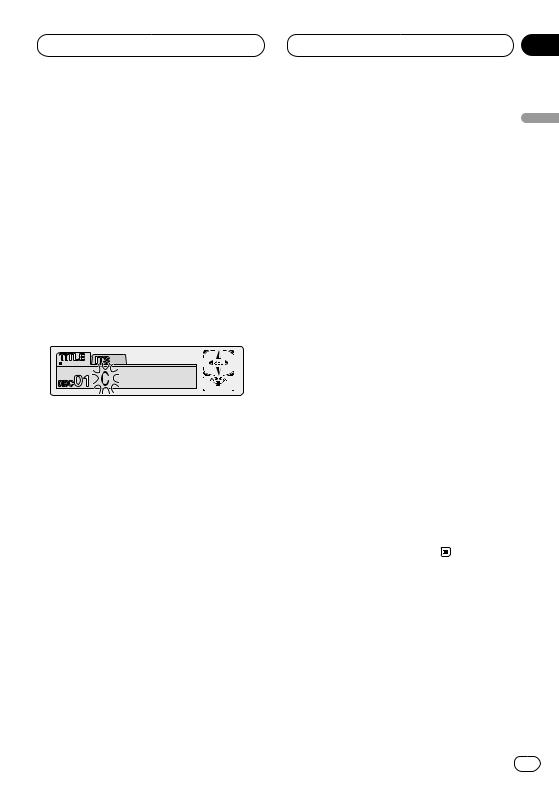
Multi-CD Player
3Press 1 numbered button to select the desired character type.
Press 1 numbered button repeatedly to switch between the following character type:
Alphabet (Upper case), Numbers and Symbols— Alphabet (Lower case)
• You can select to input Numbers and Symbols by pressing 2 numbered button.
4Press 5 or ∞ to select a letter of the alphabet.
Each press of 5 will display a letter of the alphabet in A B C ... X Y Z, numbers and symbols in 1 2
3... @ # < order. Each press of ∞ will display a letter in the reverse order, such as Z Y X ... C B A order.
5Press 3 to move the cursor to the next character position.
When the letter you want is displayed, press 3 to move the cursor to the next position and then select the next letter. Press 2 to move backwards in the display.
6Move the cursor to the last position by pressing 3 after entering the title.
When you press 3 one more time, the entered title is stored in memory.
7Press BAND/ESC to return to the playback display.
 Notes
Notes
•Titles remain in memory, even after the disc has been removed from the magazine, and are recalled when the disc is reinserted.
•After data for 100 discs has been stored in memory, data for a new disc will overwrite the oldest one.
Section
05
Displaying disc titles |
English |
|
You can display the title of any disc that has had |
||
|
||
a disc title entered. |
|
|
Press DISPLAY. |
|
|
Press DISPLAY repeatedly to switch between |
|
|
the following settings: |
|
|
PLAYBACK MODE (play time)—Disc Title (disc |
|
|
title) |
Español |
|
When you select Disc Title, the title of the cur- |
||
|
||
rently playing disc is shown in the display. |
|
|
• If no title has been entered for the currently |
|
|
playing disc, NO TITLE is displayed. |
|
|
Selecting discs from the disc title list |
Deutsch |
|
Disc title list lets you see the list of disc titles |
||
|
||
that have been entered into the multi-CD player |
|
|
and select one of them to playback. |
|
|
1 Press FUNCTION to select T.LIST. |
|
|
Press FUNCTION until disc title appears in the |
|
|
display. |
Français |
|
titles that have been entered. |
||
2 Press 2 or 3 to scroll through the list of |
|
|
• If no title has been entered for a disc, NO |
|
|
D-TITLE will be displayed. |
|
|
3 Press 5 to play your favorite CD title. |
Italiano |
|
That selection will begin to play. |
||
|
Nederlands
En 25

Section
05 Multi-CD Player
Using CD TEXT functions
You can use these functions only with a CD TEXT compatible multi-CD player.
Some discs have certain information encoded on the disc during manufacture. These discs may contain such information as the CD title, track title, artist’s name and playback time and are called CD TEXT discs. Only these specially encoded CD TEXT discs support the functions listed below.
Displaying titles on CD TEXT discs
Press DISPLAY when playing a CD TEXT disc from the multi-CD player.
Press DISPLAY repeatedly to switch between the following settings:
PLAYBACK MODE (play time)—Disc Title (disc title)—Disc Artist Name (disc artist name)—
Track Title (track title)—T-Artist Name (track artist name)
• If specific information has not been recorded on a CD TEXT disc, NO XXXX will be displayed (e.g., NO Track Title).
Scrolling titles in the display
This unit can display the first 16 letters only of
Disc Title, Disc Artist Name, Track Title and T- Artist Name. When the recorded information is longer than 16 letters, you can scroll the text to the left so that the rest of the title can be seen.
Press DISPLAY and hold until the title begins to scroll to the left.
The rest of the title will appear in the display. 
Using compression and bass emphasis
You can use these functions only with a multi-CD player that supports them.
Using COMP (compression) and DBE (dynamic bass emphasis) functions let you adjust the sound playback quality of the multi-CD player. Each of the functions have a two-step adjustment. The COMP function balances the output of louder and softer sounds at higher volumes. DBE boosts bass levels to give playback a fuller sound. Listen to each of the effects as you select through them and use the one that best enhances the playback of the track or CD that you are listening to.
1 Press FUNCTION to select COMP.
Press FUNCTION until Comp/DBE appears in the display.
• If the multi-CD player does not support COMP/DBE, No Comp is displayed when you attempt to select it.
2 Press 5 or ∞ to select your favorite setting.
Press 5 or ∞ repeatedly to switch between the following settings:
Comp OFF—Comp 1—Comp 2—Comp OFF— DBE 1—DBE 2 
26 En
